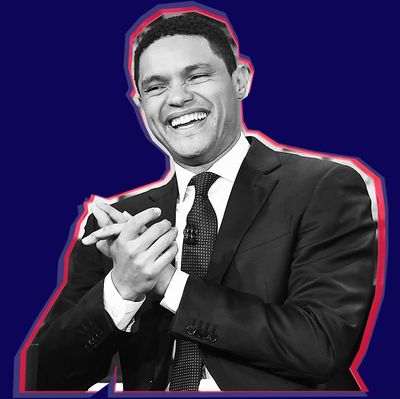
On Tuesday, May 29, the story of Roseanne Barr’s racist tweet went from developing in the morning to ABC’s canceling Roseanne by midday. It would mean late-night shows had to shift gears. By now, however, Trevor Noah and his Daily Show staff are used to something happening every day that completely changes the show. So, as they do constantly under this administration, they readjusted:
This episode is the subject of this week’s episode of Good One, Vulture Comedy’s podcast about jokes and the people who write them. Listen to the episode and read an excerpt of the discussion below. Tune in to Good One every Monday on Apple Podcasts, Spotify, or wherever you get your podcasts.
Tuesday, May 29’s episode was your first after a week and Memorial Day off. What is your mind-set after a long break?
Trevor Noah: When you come in from a long break, the most difficult part is deciding what to catch up on, what to start building towards, and then how to combine those two ideas into one show of the day. And we were not back on a Monday, so you do not kick off the week in the same way, so you are trying to figure out what pieces of the news are going to work best for that episode on the day. We also live in a world where we accept that the news is always changing. There is no such thing as “the news.” It is just news, it is happening, it is evolving. Anything can happen at any time. It is 5:30 p.m., someone is indicted for something and they plead guilty for something else, and you have to think of how you are going to include that into the show. So, what we work with is a foundation. We say, “This is what the news is right now.” I look at it like the weather — right now it is sunny but anytime it could change.
When you went to the morning meeting, how did you decide on the French African Spider-Man story and the whole next section about clarifying the story about lost immigrant children and then talking about Trump’s actual policy?
TN: That one was easy because that was really one of those rare times when the Zeitgeist seemed to be focused on one issue. That is what we are trying to do at The Daily Show. We are having a conversation that connects best with what people are talking about, and then we are at times jumping out of that and creating episodes that speak to an idea that we have. So Mamoudou — who is the man in France from Mali who climbed the building and saved the baby — that story was viral. And Emmanuel Macron taking him to the press and giving him citizenship – that is such a huge story that it is inevitable that we are going to talk about it on the show. The story of the 1,500 lost children that were lost blew up on social media. That is a bit harder because it is not happening on television. Sometimes stories break online, and now because you have a president that presidents online, you have to think of how to retell those stories.
You mean without clips that you can cut to?
TN: Yeah, there are no clips. The clips are the tweets. And people can delete the tweets and it’s like it never happened. But it did. We all felt it, but it’s gone. Imagine if someone could shoot you with dissolvable bullets. That’s what it feels like. You would be like, “Ow,” but [then there will be] nothing.
I imagine after the meeting you say, “Cool, this is what the show is,” and then all the Roseanne stuff happens so quickly that it goes from “Oh, this is a thing people are mad about” to the show is canceled over Twitter. What do you do?
Michael Kosta: Wait, what? Her show was canceled? Ah shit.
Dulcé Sloan: Michael Kosta everybody.
TN: See, this is basically what happens in the building. Everyone has a little piece of information at a different time, and some people will come out and have Michael’s reaction or somebody else’s reaction and it starts building. Then it goes from “What do you think about it?” to “What do you think about the cancellation?” to “What do you think about the reaction to the cancellation?”
Then from that point on, how is a monologue written?
TN: The first thing is that we don’t write monologues at all. The Daily Show for me, in this iteration, is a conversation that connects with the news. We are all absorbing the same news and we are all affected by the news in the same way — some of us directly and some of us indirectly. It’s a conversation transferred to the camera and then to our audience. So, it will be a conversation between me and Roy and we will say, “Hey, did you see this? What did you think? Why did you think that?” et cetera, et cetera. It will be Desi and I chatting, Ronny will say something, Dulcé will come running down the hall and tell me a crazy story. And so really it is just about figuring out how to have that conversation with the audience and in such way that the show feels like it has a purpose, but it also doesn’t feel staid and stuck in a format that doesn’t really do what I would like to do.
Will you write a collection of jokes and weave it into something more written through?
TN: I’ll go the other way around. I’ll say, “What is the news, what are the facts, what’s the truth?” and then we will put the jokes on top. It’s the icing on the cake.
I have heard you talk about how it’s important for you to not have your intro pieces be angry. Why did you make that decision? Especially coming from Jon [Stewart], who towards the end he was known for a righteous anger.
TN: That is one of the best pieces of advice Jon gave me. When Jon announced that he was leaving I was lucky enough to be working on the show. I walked into his office and I said, “Hey, what’s going on? Are you being pushed out or what’s happening? Do you need my help? Let me know, man. We’ll fight.” And Jon said, “No, I’m leaving.” And I said, “Why though?” And he said, “I am leaving because I am tired. I am tired of being angry. I am angry all the time. I don’t find any of this funny. I don’t know how to make it funny right now and I don’t think the show deserves a host who does not feel that it is funny.” And he said, “When you become the host, live and relish that moment. Relish the fact that you can make jokes about these things. Because there will come a day where you will be too angry to laugh. But don’t rush to get there. You are young and you’re fresh, so enjoy the moments when you still have the energy.”
And in many ways it reminded me of what my mother would say to me. She would be like, “When you are a young parent you can’t chase your child. You can chase them and you can beat them because you have the energy.” [Audience laughs.] In Africa we beat; get over it.
DS: We beat here too, don’t worry. We are still black. We’re just on the other side.
TN: And so my mom said, “But when you are older, you don’t have the energy for kids anymore. You don’t have the energy for that. You don’t have the energy to be as angry.” So, I realize that I have a space that I exist in as a human being where I use laughter and we by proxy as a show use laughter as a mechanism to help us deal with the very real world we are living in. It doesn’t minimize what’s happening, it doesn’t trivialize it, but it gives us a tool to deal with what’s happening. What’s really important to me is existing in that space, so I don’t chase the anger and I also don’t fake the anger.
People will be like, “Why aren’t you more angry?” It’s like, “I’ll be angry when I’m angry.” I’m not playing a character on TV. I am myself, as Trevor. I think the team can agree with that — who I am on camera I’m trying to get that as close to who I am all the time. So, I want you to have a visceral and real understanding of how I feel, and, by proxy, how everyone else feels. I don’t want Kosta to go on TV and have a feeling that is completely foreign to what he believes in. I want Desi to imbue a piece of herself in every piece. I want Ronnie’s rage to come through in the charming way that it does. And that’s what’s really important to me — is having that feeling and the authenticity in the show.
Roy, you also recently had a piece on this show.
Roy Wood Jr.: Yes, yes I did.
You made your version of a Starbucks training video because Tuesday was the day that they closed down to give racial bias training. How and when did that come together?
RWJ: A lot of that was cooked up by the writers in the weeks prior. About two weeks before, as I call it, “training day” for Starbucks, we figured out what would be the best way to tackle that — what would the world look like without Starbucks for a day, what would the training be like — and there were a lot of different ideas thrown around the building. Knowing that the training video would be internal, we landed on “What would the training video look like?” From there it was about working out the beats of what this training video would look like. Then we rented out a coffee shop and shot a full-blown mock Starbucks video, which according to a lot of Starbucks employees on Twitter, and you can verify this, was about 80 percent spot-on to exactly what they saw in the stores that day. So, we know our audience.
What is it like to talk about immigration so seriously and then, in the last act, talk to Johnny Knoxville about his eye falling out making a movie?
TN: That’s balance and that’s life. Life is about talking about immigration and then talking about Johnny Knoxville breaking his face. Isn’t that life? That’s what I have always loved, that’s why I like The Daily Show — we are not one-dimensional. We can have fun. It is very important for myself as a human being and for the show to exist in a very honest space, where, yes, we may live in a world where we are terrified because of Donald Trump and what’s happening in the world around us, but we also can’t act like we don’t laugh as human beings; we can’t act like we don’t have lives to live. I don’t want to exist as one state where I am only angry and only afraid, because then I forget what I am trying to get to in the end. It’s really the balance that we are trying to create. So it’s great to me to have a serious story about immigration and migrant children and refugees and then have Johnny Knoxville come on at the end and talk about how he does his own stunts and breaks his face into thousands of pieces.


